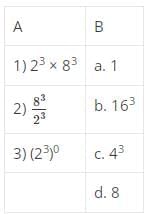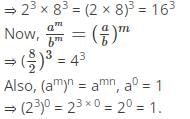MCQ (with Solutions): Power Play | Mathematics Class 8- New NCERT (Ganita Prakash) PDF Download
Q1: Find the value of 
(b) 1/64
(c) 16
(d) 64
 View Answer
View Answer 
Ans: (d)

Q2: Find the value of 16-2 × 1614.
(a) 1612
(b) 16-12
(c) 1614
(d) 16-14
 View Answer
View Answer 
Ans: (a)
am × an = am + n
⇒ 16-2 × 1614 = 16-2 + 14 = 1612.
Q3: Match the pairs.
(b) 1-b, 2-c, 3-a
(c) 1-c, 2-b, 3-a
(d) 1-c, 2-b, 3-d
 View Answer
View Answer 
Ans: (b)
am × bm = (ab)m

Q4: What is 2-3?
(a) 1/4
(b) 1/8
(c) 4
(d) 8
 View Answer
View Answer 
Ans: (b)

Q5: Evaluate 
(b) 21-25
(c) 2124
(d) 21-24
 View Answer
View Answer 
Ans: (c)

Q6: Find the value of (2)3 (2)2
(a) 128
(b) 16
(c) 32
(d) 64
 View Answer
View Answer 
Ans: (c)
(a)m(a)n = am+n
= 25 = 32.
Q7: What is the multiplicative inverse of 10-3?
(a) 100
(b) -100
(c) 1/1000
(d) 1000
 View Answer
View Answer 
Ans: (d)
Multiplicative inverse of an = 1/an
⇒ Multiplicative inverse of 10-3 = 103 = 1000.
Q8: Find the value of 3-2.
(a) 1/9
(b) 
(d) 1/8
 View Answer
View Answer 
Ans: (a)

Q9: What is the value of 10-6?
(a) -0.000010
(b) -0.0000010
(c) 0.000010
(d) 0.0000010
 View Answer
View Answer 
Ans: (d)
⇒ 10-6 = 0.0000010.
Q10: Find the unknown value: 1/729 = 9-m.
(a) -4
(b) -3
(c) 3
(d) 4
 View Answer
View Answer 
Ans: (c)

|
26 videos|133 docs|11 tests
|
FAQs on MCQ (with Solutions): Power Play - Mathematics Class 8- New NCERT (Ganita Prakash)
| $1. What is the concept of power play in sports and how does it impact the game? |  |
| $2. How do teams prepare for power play situations in sports? |  |
| $3. What are some historical examples of significant power plays that changed the outcome of a game? |  |
| $4. How does the concept of power play differ between sports like cricket and hockey? |  |
| $5. What skills are essential for players to effectively utilize power play situations? |  |

















